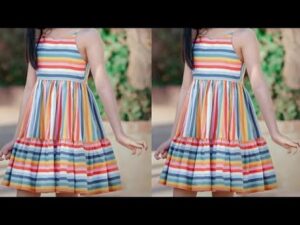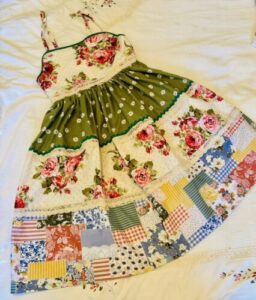Uncategorized
Why Handmade Clothes Are Making a Comeback in Kids’ Fashion
In an era dominated by fast fashion and mass production, handmade clothes are experiencing a revival, especially in kids’ fashion. Parents are increasingly turning to artisanal, hand-crafted garments as a sustainable, unique, and meaningful alternative to factory-made clothing. This trend reflects a growing appreciation for quality, individuality, and the human touch that handmade clothes bring to a child’s wardrobe.
Here’s why handmade clothes are making a comeback and how they’re redefining kids’ fashion.
1. The Appeal of Uniqueness
One of the main reasons handmade clothes are gaining popularity is their uniqueness.
- Individualized Designs: Unlike mass-produced items, handmade clothes often feature unique patterns, designs, and details, ensuring no two pieces are exactly alike.
- Customization: Many artisans and small brands offer custom sizing, colors, or embroidery, allowing parents to create clothing that reflects their child’s personality.
- Sentimental Value: Handmade clothes often carry a story, whether it’s the skill of the maker, the materials used, or the reason behind the design.
Parents value the chance to dress their children in something truly special, helping them stand out in a sea of identical outfits.
2. Sustainability and Eco-Friendliness

Handmade clothes are a cornerstone of sustainable fashion, which is becoming increasingly important for eco-conscious parents.
- Reduced Waste: Artisans often produce clothes in small batches or on demand, minimizing overproduction and waste.
- Eco-Friendly Materials: Many handmade garments use natural, organic, or recycled fabrics, reducing the environmental footprint.
- Longevity: Handmade clothes are typically crafted with durability in mind, lasting longer than fast-fashion alternatives.
By choosing handmade clothing, parents support a sustainable approach to fashion that aligns with their values.
3. Superior Craftsmanship and Quality
Handmade clothes are synonymous with quality and attention to detail.
- Artisanal Techniques: Skilled makers invest time and care into each piece, ensuring higher quality stitching, finishes, and overall construction.
- Durable Designs: The focus on craftsmanship results in garments that can withstand the rigors of active kids, making them ideal for play and everyday wear.
- Heirloom Potential: Well-made handmade clothes can be passed down to siblings or even future generations, adding sentimental and practical value.
Parents are willing to invest in clothing that stands the test of time, both in terms of durability and style.
4. Connection to Tradition and Heritage
Handmade clothes often incorporate traditional techniques, patterns, or cultural motifs, offering a meaningful connection to heritage.
- Celebrating Craftsmanship: Techniques like hand-knitting, embroidery, and weaving honor traditional crafts passed down through generations.
- Cultural Representation: Handmade clothes can showcase cultural identity through specific patterns, colors, or designs.
- Supporting Artisans: Purchasing handmade clothing often means supporting small businesses or local craftspeople, preserving these skills for future generations.
This cultural and personal connection resonates with parents who want to celebrate their own traditions or expose their children to global artistry.
5. A Rejection of Fast Fashion
Fast fashion has been criticized for its environmental impact, exploitative labor practices, and low-quality products. Handmade clothing offers a meaningful alternative.
- Ethical Production: Artisans and small brands often prioritize fair labor practices, ensuring makers are paid fairly for their work.
- Slow Fashion Values: Handmade clothes align with the principles of slow fashion, focusing on quality, sustainability, and conscious consumption.
- Mindful Shopping: Parents are increasingly rejecting disposable clothing in favor of items that reflect care and intentionality.
By choosing handmade, parents contribute to a more ethical and responsible fashion industry.
6. Supporting Small Businesses and Local Makers
Handmade clothing often comes from independent artisans, small businesses, or community workshops.
- Empowering Makers: Purchasing handmade clothing helps support skilled craftspeople and small business owners, many of whom rely on these sales as their livelihood.
- Building Relationships: Many parents enjoy the personal connection that comes from interacting with the maker, whether through custom orders or shared stories.
- Fostering Community: Supporting local makers strengthens community ties and promotes a sense of connection in an increasingly globalized world.
This direct support of artisans makes each purchase feel more meaningful and impactful.
7. Timeless Aesthetic and Style

Handmade clothes often feature timeless designs that transcend trends.
- Neutral Colors and Classic Patterns: Many handmade garments focus on simple, elegant styles that are easy to mix and match.
- Vintage Inspiration: Hand-crafted clothing often incorporates vintage details like lace trims, smocking, or hand-stitched embellishments, adding charm and character.
- Avoiding Trends: Handmade items are designed to last, making them a practical choice in a world of fleeting fashion fads.
Parents appreciate the understated elegance of handmade clothes, which remain stylish and versatile season after season.
8. Educational Opportunities for Kids
Handmade clothes can also serve as a teaching tool for children.
- Appreciating Craftsmanship: Kids can learn about the effort and skill that goes into making their clothes, fostering a deeper respect for artisans.
- Understanding Sustainability: Handmade clothing introduces concepts like sustainable consumption and environmental responsibility in an age-appropriate way.
- Encouraging Creativity: Involving children in the design process or DIY clothing projects sparks their imagination and creativity.
Teaching kids about handmade clothing helps them grow into mindful and appreciative consumers.
9. Handmade in the Digital Age
The rise of e-commerce and social media has made handmade clothing more accessible than ever.
- Global Reach: Platforms like Etsy and Instagram allow artisans to showcase their creations to a worldwide audience.
- Custom Orders: Many artisans offer the ability to personalize designs, creating one-of-a-kind pieces tailored to specific needs.
- Transparency: Social media gives customers insight into the making process, creating a stronger connection between maker and buyer.
This digital accessibility has brought handmade clothing into the mainstream, making it a viable choice for modern parents.
10. The Future of Handmade Kids’ Fashion
As more parents embrace ethical and sustainable shopping habits, the demand for handmade kids’ clothing is expected to grow.
- Innovation Meets Tradition: Modern artisans are blending traditional techniques with contemporary aesthetics, appealing to a wide range of tastes.
- Increased Accessibility: Continued growth in online marketplaces and social media will make handmade clothing more affordable and accessible to families everywhere.
- A Shift in Values: The focus on quality, sustainability, and individuality in handmade clothing aligns with the values of the next generation of parents.
The resurgence of handmade clothing is more than a passing trend—it represents a lasting change in how we value and consume fashion.
Conclusion
Handmade clothes are making a comeback in kids’ fashion for good reason. They offer a unique blend of quality, sustainability, and personal connection that mass-produced items simply can’t match. By choosing handmade clothing, parents support skilled artisans, prioritize eco-conscious practices, and celebrate individuality in their children’s wardrobes.
At Regal XX Hue, we’re proud to offer a curated collection of handmade kids’ clothing, blending timeless designs with impeccable craftsmanship. Explore our collection and discover the charm of handmade fashion for your little ones!


